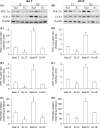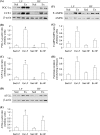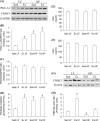Thermogenic capacity is antagonistically regulated in classical brown and white subcutaneous fat depots by high fat diet and endurance training in rats: impact on whole-body energy expenditure
- PMID: 25344623
- PMCID: PMC4256346
- DOI: 10.1074/jbc.M114.591008
Thermogenic capacity is antagonistically regulated in classical brown and white subcutaneous fat depots by high fat diet and endurance training in rats: impact on whole-body energy expenditure
Abstract
This study investigated the regulation of thermogenic capacity in classical brown adipose tissue (BAT) and subcutaneous inguinal (SC Ing) white adipose tissue (WAT) and how it affects whole-body energy expenditure in sedentary and endurance-trained rats fed ad libitum either low fat or high fat (HF) diets. Analysis of tissue mass, PGC-1α and UCP-1 content, the presence of multilocular adipocytes, and palmitate oxidation revealed that a HF diet increased the thermogenic capacity of the interscapular and aortic brown adipose tissues, whereas exercise markedly suppressed it. Conversely, exercise induced browning of the SC Ing WAT. This effect was attenuated by a HF diet. Endurance training neither affected skeletal muscle FNDC5 content nor circulating irisin, but it increased FNDC5 content in SC Ing WAT. This suggests that locally produced FNDC5 rather than circulating irisin mediated the exercise-induced browning effect on this fat tissue. Importantly, despite reducing the thermogenic capacity of classical BAT, exercise increased whole-body energy expenditure during the dark cycle. Therefore, browning of subcutaneous WAT likely exerted a compensatory effect and raised whole-body energy expenditure in endurance-trained rats. Based on these novel findings, we propose that exercise-induced browning of the subcutaneous WAT provides an alternative mechanism that reduces thermogenic capacity in core areas and increases it in peripheral body regions. This could allow the organism to adjust its metabolic rate to accommodate diet-induced thermogenesis while simultaneously coping with the stress of chronically increased heat production through exercise.
Keywords: AMP-activated Kinase (AMPK); Adipose Tissue Metabolism; Exercise; Obesity; Peroxisome Proliferator-activated Receptor γ Coactivator 1-α (PGC-1a) (PPARGC1A); UCP-1, FNDC5, Irisin, Brown Adipocytes, ATGL.
© 2014 by The American Society for Biochemistry and Molecular Biology, Inc.
Figures








Similar articles
-
The effects of acute and chronic exercise on PGC-1α, irisin and browning of subcutaneous adipose tissue in humans.FEBS J. 2014 Feb;281(3):739-49. doi: 10.1111/febs.12619. Epub 2013 Dec 10. FEBS J. 2014. PMID: 24237962 Clinical Trial.
-
Two key temporally distinguishable molecular and cellular components of white adipose tissue browning during cold acclimation.J Physiol. 2015 Aug 1;593(15):3267-80. doi: 10.1113/JP270805. Epub 2015 Jul 14. J Physiol. 2015. PMID: 26096127 Free PMC article.
-
Exercise as a new physiological stimulus for brown adipose tissue activity.Nutr Metab Cardiovasc Dis. 2013 Jun;23(6):582-90. doi: 10.1016/j.numecd.2012.01.013. Epub 2012 May 26. Nutr Metab Cardiovasc Dis. 2013. PMID: 22633794
-
Brown adipose tissue and thermogenesis.Horm Mol Biol Clin Investig. 2014 Jul;19(1):25-37. doi: 10.1515/hmbci-2014-0022. Horm Mol Biol Clin Investig. 2014. PMID: 25390014 Review.
-
Origins and early development of the concept that brown adipose tissue thermogenesis is linked to energy balance and obesity.Biochimie. 2017 Mar;134:62-70. doi: 10.1016/j.biochi.2016.09.007. Epub 2016 Sep 10. Biochimie. 2017. PMID: 27621146 Review.
Cited by
-
Comparison of Diet versus Exercise on Metabolic Function and Gut Microbiota in Obese Rats.Med Sci Sports Exerc. 2016 Sep;48(9):1688-98. doi: 10.1249/MSS.0000000000000964. Med Sci Sports Exerc. 2016. PMID: 27128671 Free PMC article.
-
AMP-activated protein kinase activation in skeletal muscle modulates exercise-induced uncoupled protein 1 expression in brown adipocyte in mouse model.J Physiol. 2022 May;600(10):2359-2376. doi: 10.1113/JP282999. Epub 2022 Apr 5. J Physiol. 2022. PMID: 35301717 Free PMC article.
-
Circulating fibroblast growth factor 21 is reduced, whereas its production is increased in a fat depot-specific manner in cold-acclimated rats.Adipocyte. 2018;7(4):238-247. doi: 10.1080/21623945.2018.1504591. Epub 2018 Sep 20. Adipocyte. 2018. PMID: 30059270 Free PMC article.
-
Exercise Training Induces Depot-Specific Adaptations to White and Brown Adipose Tissue.iScience. 2019 Jan 25;11:425-439. doi: 10.1016/j.isci.2018.12.033. Epub 2019 Jan 3. iScience. 2019. PMID: 30661000 Free PMC article.
-
New Insights into Molecular Mechanisms Mediating Adaptation to Exercise; A Review Focusing on Mitochondrial Biogenesis, Mitochondrial Function, Mitophagy and Autophagy.Cells. 2021 Oct 2;10(10):2639. doi: 10.3390/cells10102639. Cells. 2021. PMID: 34685618 Free PMC article. Review.
References
-
- Cinti S. (2009) Transdifferentiation properties of adipocytes in the adipose organ. Am. J. Physiol. Endocrinol. Metab. 297, E977–E986 - PubMed
-
- Cannon B., Nedergaard J. (2004) Brown adipose tissue: function and physiological significance. Physiol. Rev. 84, 277–359 - PubMed
-
- van Marken Lichtenbelt W. D., Vanhommerig J. W., Smulders N. M., Drossaerts J. M., Kemerink G. J., Bouvy N. D., Schrauwen P., Teule G. J. (2009) Cold-activated brown adipose tissue in healthy men. N. Engl. J. Med. 360, 1500–1508 - PubMed
-
- Virtanen K. A., Lidell M. E., Orava J., Heglind M., Westergren R., Niemi T., Taittonen M., Laine J., Savisto N.-J., Enerbäck S., Nuutila P. (2009) Functional brown adipose tissue in healthy adults. N. Engl. J. Med. 360, 1518–1525 - PubMed
Publication types
MeSH terms
Substances
LinkOut - more resources
Full Text Sources
Other Literature Sources
Medical
Research Materials
Miscellaneous

